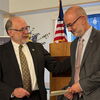UMaine System endorses move to joint accreditation, approves USM construction
 Courtesy / University of Maine System
Courtesy / University of Maine System
The University of Maine System has taken a next step in obtaining a single, common accreditation for its seven member institutions.
Instead of each school maintaining its own academic accreditation, the UMaine System hopes future evaluation of the state’s public universities will be based on how well they share resources in service to students and the state, according to a news release.
The system’s board of trustees on Monday unanimously endorsed the transition.
Unified accreditation offers the opportunity for Maine's universities to work together to offer academic programming they can’t offer on their own, and to share administrators, faculty, technology, and other resources and best practices to improve the overall quality of the student experience and the universities themselves.
“As best we can determine, for the first time in the nation, all of a state’s public universities will be evaluated based on how well they share the state’s resources in service to students in the important elements of mission, governance, academic program, student services, institutional resources, teaching, learning, and scholarship, and educational effectiveness,” Chancellor Dannel Malloy wrote in a message on the system’s “unified accreditation” website.
The New England Commission of Higher Education is the regional accreditation agency for colleges and universities in Maine, Connecticut, Massachusetts, New Hampshire, Rhode Island and Vermont.
Institutions of higher learning achieve accreditation by demonstrating they meet the commission’s standards for institutional quality and carry out evaluative processes designed to encourage improvement.
Except for the University of Maine at Machias, which is accredited as a regional campus of the University of Maine, the University of Maine and other five universities in the system are separately accredited. That means each must govern its own academic programs, which doesn’t provide for efficient administration and assessment for programs that are offered jointly, according to Malloy’s September 2019 recommendation to the trustees.
State law that establishes higher education public policy says one of the system’s top priorities is to coordinate academic programming to serve the entire state, says Malloy.
“[I]ndeed, coordinated academic programming to serve the entire state of Maine was one of the core expectations the system’s formation was meant to realize more than 50 years ago,” he wrote.
As part of the transition to a common accreditation, the UMaine System is committed to maintaining the universities where they currently are and to expanding opportunities for them to share resources, according to the news release.
The reform has been under consideration since the formation of the system in 1968.
Collaboration in public education is key to “up-skilling more Mainers with the tools and talent needed for success by providing flexible, life-long access to relevant, 21st century learning,” James Erwin, chairman of the system’s board of trustees, said in the release.
The unified approach is expected to support significantly more multi-campus academic programs.
Malloy and university presidents collaborated on a set of guiding principles to serve as a road map for engagement, plan development, and the transition from separate to unified accreditation. Principles include a commitment to keeping universities where they currently exist, adhering to collective bargaining agreements, and the assurance that faculty will continue their shared governance role in academic policy and curriculum development at the system level.
Malloy then kicked off a “campaign of participation” that included 46 town halls and discussions with the university community. He also established a “unified accreditation” website to post historic documentation on accreditation issues, communicate with stakeholders, and respond directly to questions.
“We visited each campus at least three times, held hundreds of conversations, and, when questions were asked, we responded the very next day,” said Malloy.
Next, Malloy and the university presidents will prepare and submit a substantive change application to the commission by June 30.
Upon approving the substantive change request, the commission will determine further steps to evaluate the system’s quality and effectiveness in its transition to unified accreditation. Those steps could include a confirming visit within six months and a comprehensive evaluation within two years.
Malloy has established an academic and student affairs advising committee and finance, administration, and student support services committee to oversee the work. He will also co-convene a unified accreditation coordinating council.
The transition is expected to provide more and better educational opportunities to students and make more effective use of scarce resources for the state’s taxpayers, Terry W. Hartle, American Council on Education’s senior vice president of government relations and public affairs, said in the release.













0 Comments